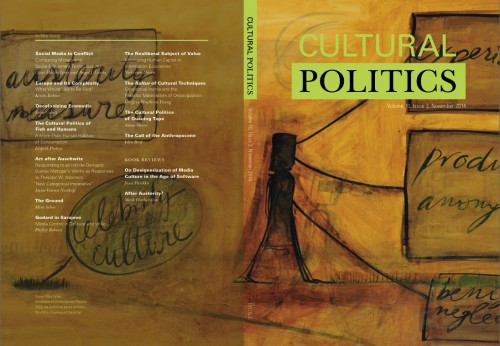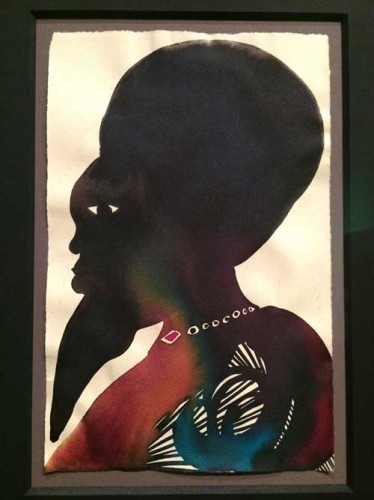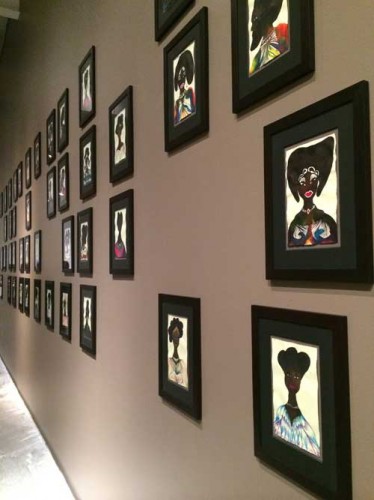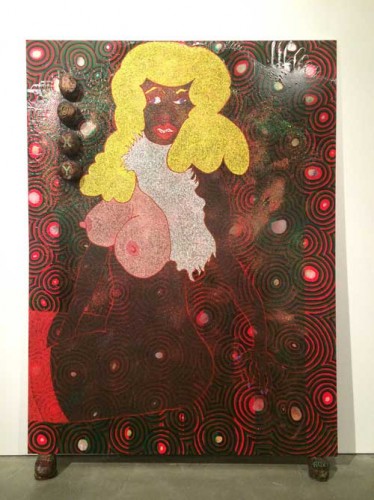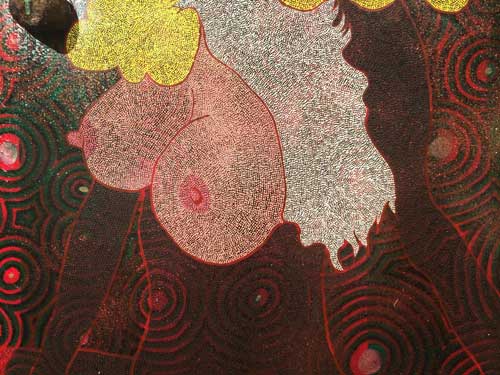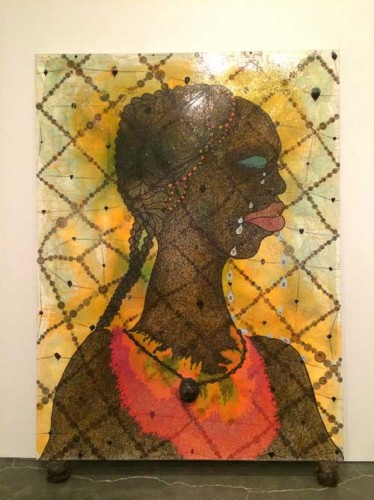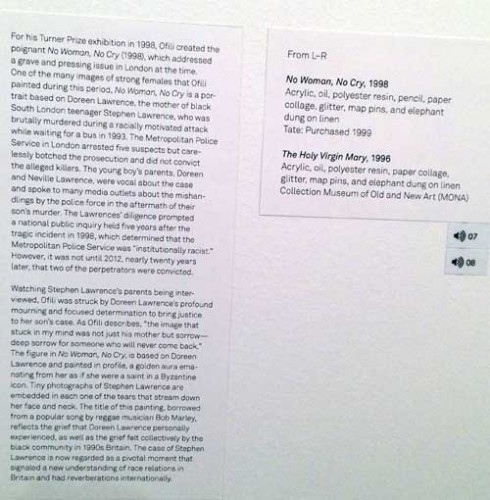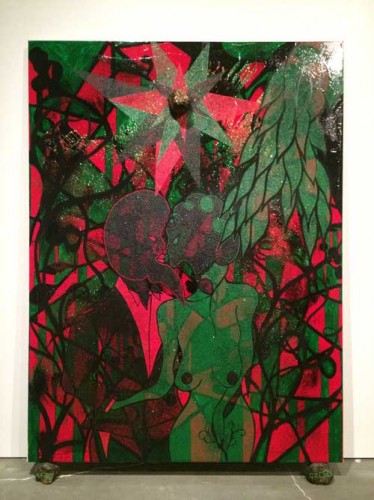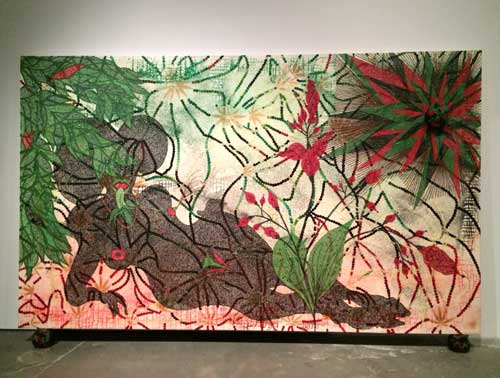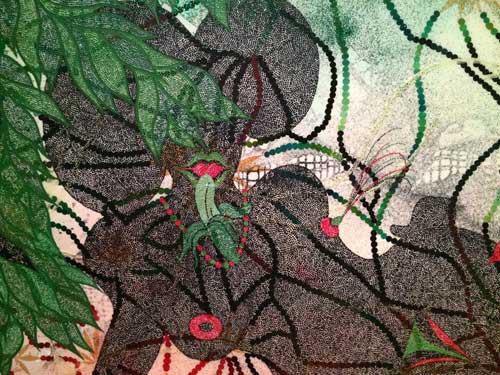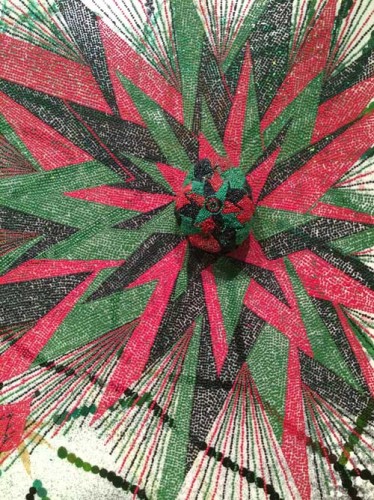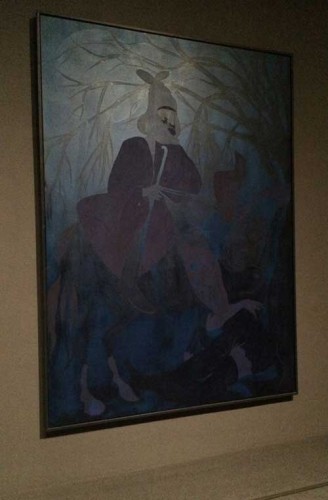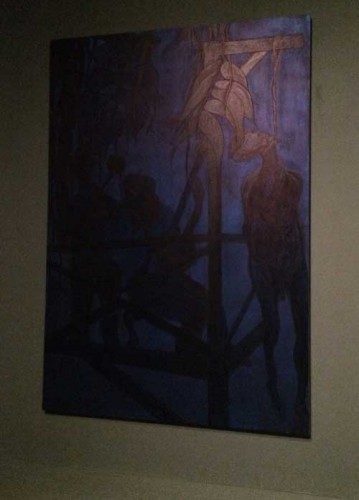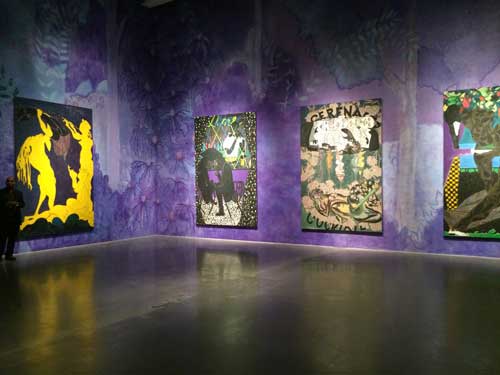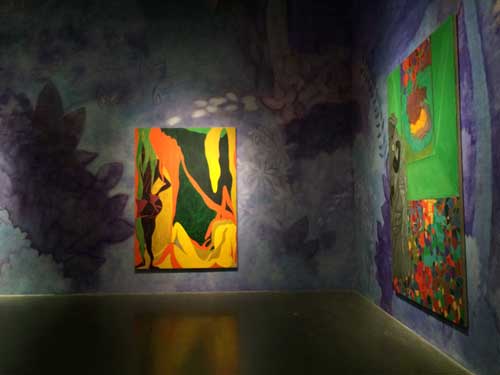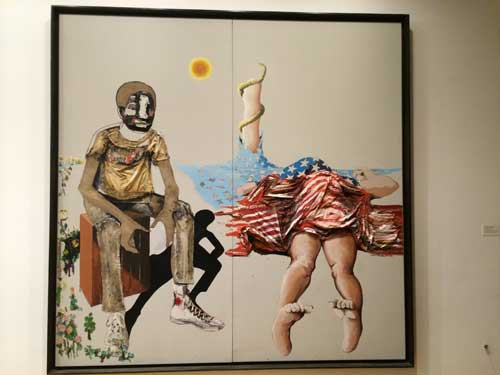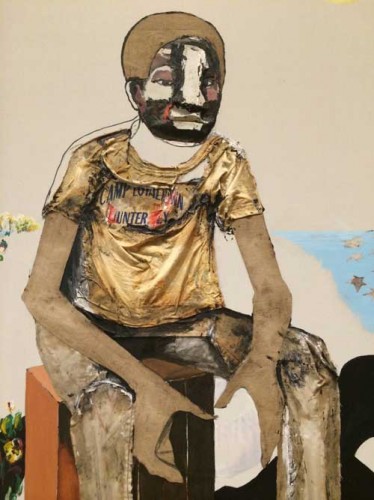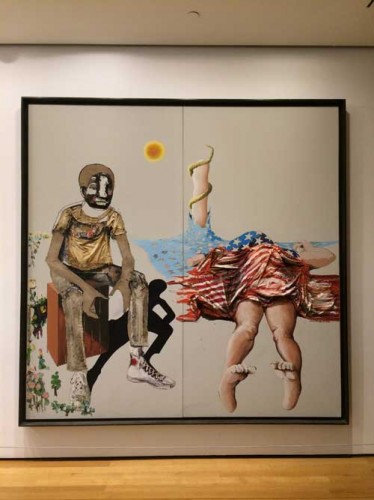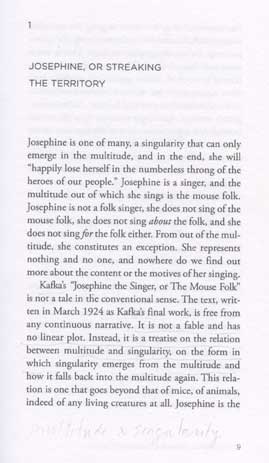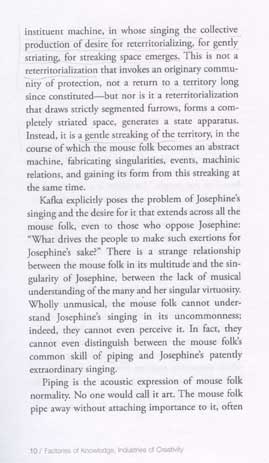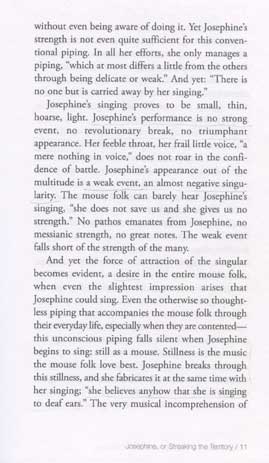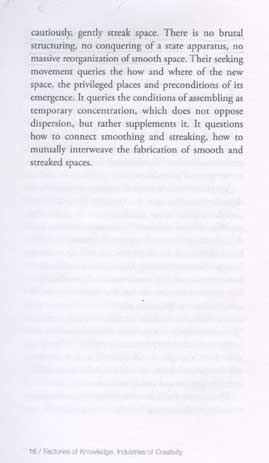1. One certainty is that when you put together a panel or lecture series with the word feminist in it, a lot of people will show up because people, mostly women, are always hungry to have someone tell them something about feminism. It is a word that appears like a chimera and a promise. Maybe they will finally learn the answer to the puzzle of the unequal status of women in most societies.
2. Feminism is always in a state of revival, because any culture whose actual practices subjugate and devalue women one way or another cannot incorporate it into collective memory, even that of women.
3. The task of the political activist is to keep saying the same thing over and over again, repeating the same history, over and over again for decades, and greeting new arrivals to the cause with enthusiasm rather than despair. I am not always so cheerful about it.
Tweet around 9:05PM Thursday September 18 from the all too appropriately titled The Hole: @miraschor: Future feminism. Preview: is there something more basic than feminism 101? So naive & essentialist it’s all I can do not to walk out.
Earlier this month, promotional material began to circulate about an exhibition and series of events at the downtown New York exhibition space, The Hole, titled Future Feminism. The events seemed diverse and also suspect. When you see Marina Abramovic listed as a guest speaker at yet another “feminist” event, warning alerts sound for anyone who has attended any number of major feminist symposia, such as at “The Feminist Future: Theory and Practice in the Visual Arts” a two-day symposium that was held at MoMA in January 2007 and heard her inevitably begin her talk with the words, “I am not feminist artist.” It’s not that I don’t believe her, in fact I do believe her. If she says she isn’t, she isn’t. Unfortunately the complex story of her personal and artistic biography in relation to a feminist narrative and how she has learned to play the dynamics of the art world’s intersection with fame and fashion is lost on young women artists around the world who emulate her because her fame is less and less problematized the farther away it expands globally, becoming a brand rather than an artist. She’s a woman, she uses her body (now she uses other people’s bodies), she’s famous, this must be a feminist model. But if she is asked yet again to speak at a “feminist” event, then you know some star fucking is going on rather than some serious thinking about feminism…. OK never mind. Point two: what were these “13 tenets of Future Feminism” they were proclaiming? I only saw the full list last night at the panel. I’ll get to that presently.
Oh don’t let me forget the T-shirts: adjacent to the main door of the gallery is a separate storefront which was festooned with T-shirts with the slogan “The future is Female.” In the window were two blackboards, one advertised the price for the T-shirts at $20 and the other for $25. I was trying to figure out whether there were two different designs when, as the line waiting outside filled out, the young woman in the store came over, tipped the signs back so she could see them, and removed the one with the $20 price.
The women of my generation, what I’ve called “Generation 2.5”, show up for these things. We have a lot of history in feminism but we want to know what’s going on too, in a different way than the people who show without any previous background in feminism and who have that inchoate longing for an answer. So a friend suggested we go hear feminist Ann Snitow interview the “Future Feminists,” and we ran into a group of women artists friends who were there for the same reason: let’s see what this is.
And that is the basic thing: we had come to hear what these people had to say.
Eventually the speakers filed in and took their place. And then it took about a half hour until we actually heard them say anything because Ann Snitow made the peculiar choice of asking a man to talk to us about listening.
That is, Snitow had waxed enthusiastic about the FFs, how this group of friends had taken a vacation and they had talked to each other, about feminism, and this was what Consciousness Raising was, they had reinvented CR, they were interested in circles, circular forms of governance, they wanted nothing less than everything; that is to say that after Snitow had failed in introducing this group we had come to learn about, by failing to fully introduce each person, and by failing to give them any kind of historical context–as it turns out, they don’t seem to have any, but it was her responsibility as a long time feminist educator to situate these people in relation to some kind of history–after this very enthusiastic and very uninformative introduction, just as we thought we would hear from members of the group, she asked Robert Sember of Ultra-red to talk to us about listening.
And so he did, for at least 15 or maybe 20 minutes. As he went on my mind was increasingly torn between thinking, on the one hand, well this is kind of interesting–he spoke about the practice of intentional listening, space made for listening in non-hierarchical ordering of processes of change, he said that Ultra-red had been engaged in a deep investigation of the intentional practice of listening in social movements. He mentioned that women in the civil rights movement had created listening circles, building literacy out of experience, conversation into action–as he said this, having spoken by now for several minutes, and he was not the speaker we had come to hear, I thought about how the treatment of women in the civil rights and anti-war movements led directly to the women’s liberation movement, I remembered that when asked what the position of women was in SNCC (Student Non-Violent Coordinating Committee) Stokely Carmichael said, “the only position for women in the movement is prone,” and how my anger at the casual sexist injustice of that statement was certainly part of my own early attraction to the feminist movement–by the way this well known snarky quip is not included in online collections of significant statements by Carmichael but of course he was a brilliant and dynamic figure and had a lot to say.
Sember continued, emphasizing that the commitment to actually really listen is a profound act of solidarity and care, of love in the name of the future, of transformation, of the reordering of power. He then noted that the Future Feminists were indeed a collective–later Antony said they were not really a collective, they were just a bunch of friends who hung out together. Sember made an interesting distinction between activism, where there are ones in the know, experts, where it is strategic to speak with one voice, and organizing, which is a long term process of working together, woven together by process, learning and developing. So the FFs had engaged in CR, how is feminism practiced and lived, the building of the “we,” CR had held generalizations about women up to their own experience.
At this point, I interrupted my long time practice of verbatim note taking to insert a personal comment in my notebook: It is weird to have this lectured to us–at us– with the confident voice of a white man.
He continued: The question for us tonight, what do we know? What brought you here? What did you come here to hear? He then asked for a moment of silence.
During which I continued my commentary in my notes, the other side of my brain spoke, the side that drew me to feminism: I kind of resent this quasi religious confident male voice lecturing to me about listening and Consciousness Raising and feminism even if what he is saying is of some interest. Rebecca Solnit has wonderfully named this phenomenon as “mansplaining.” It’s important to distinguish between that which patriarchy offers of history, literature, and art, which is valuable, and that I insist on assuming as my own heritage, and the mechanism of power always devolving to the male voice, so confident, so privileged, even when it is taking the side of the underprivileged. The rebellion is not so much in my anger at being talked at but in assuming a voice of my own and giving others a voice too if possible.
Now, a half hour into this event, held in a hot airless room which had been recently painted white so that it reeked of new paint fumes, would we begin the actual Q & A with the Future Feminists?
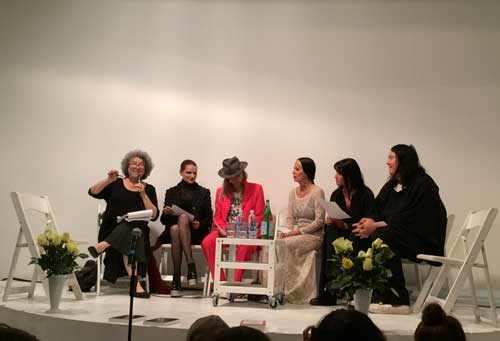
No.
We were now asked to turn to the person in back of us, in alternating rows, and talk. The very nice young man in front of me asked me what I thought about the 13 tenets, copies of which were on each seat. I said I couldn’t believe how essentialist it all was and how out of keeping with the time it was to use words like feminine and female without problematizing them and to unquestioningly link women with nature, and he totally agreed. We had a nice chat. He had no idea of my history and I have no idea if he was familiar with the debate within feminism during the 1980s over essentialism and how corrosive it could be, which means that he had no idea that if the lady he was talking to said that something was essentialist, then the amnesiac wheel has definitely turned. Young man, you are blonde and were wearing a dark cap which I was going to ask you to take off before I spoke to you, because it was blocking my view, but after I talked to you I didn’t mind anymore; if you are out there and see this blog post, I was the lady with short white hair and multicolored reading glasses. Just want to say hello.
When the conversation finally turned to the panelists, their vagueness was such that the discussion somehow immediately reverted back to the audience. Someone asked about the gendering of language. The toxic paint fumes or the perilous effects of déja vu on the brain made me freeze. Someone suggested the word God. Only two days later did I remember that old chestnut of an example, history.
Tweet around 9:09PM: @miraschor: Language defaults to “he.” Yes, anyone here heard of Mary Daly? These people seem sweet but apparently just landed on Earth & they aren’t that young. But at last someone in the audience asks why the ” tenets” of this group are so binarist and points out there are a lot of people in the room who have been working on this — feminism– for a long time.
The audience member challenged the group: Where is the transgender in these tenets? What are your racial politics?
At this point Antony said that they were not really a collective, but an affinity group, of friends, who “took time out of capitalism to talk.” Well that is interesting. I’ve been part of groups of women who have taken time out of capitalism for all of our lives to talk. It is indeed a wellstone of strength but if you get up in front of people you have to have a bit more to say. These are performance artists, they should at least know that. At $10 admission fee. Give the audience something. But, Antony continued, “the crowd in the room is the dream we all envisioned.” If you reverse engineer that, you may end up somewhere else: we wanted an audience and we thought, hey feminism seems like something, it’s been somnolent for years, until three years ago when Pussy Riot…OMG, that is a very limited way of looking at the history of feminism and by the way, as I said, Antony said this, because,
Tweet around 9:16PM: @miraschor: By the way men are doing most of the articulate speaking. White men telling us how important it is to listen.
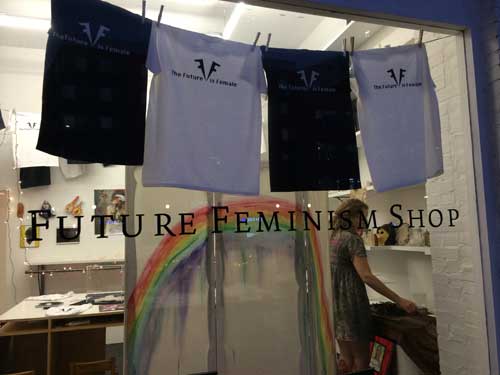
Snitow asked them how they came to choose the word feminist. They said they had looked it up in the dictionary and it seemed perfect. …… They talked about how dangerous it was to use the term.–FYI, cf. my essay “The ism that dare not speak its name.” They asked, why does misogyny exist? A good question. But no one on the panel seemed to speak from experience of misogyny or a personal history with feminism, feminism was something they might have picked up in the Future Feminism gift shop adjoining the gallery. Not one of the women in the group seemed to speak from a lived existence of experiencing discrimination or misogyny.
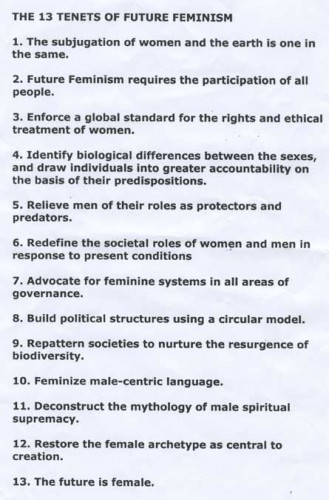
I had wanted to leave the event early on, mansplaining does that to me, but my natural drive to see things through because you never know what you might miss if you leave an event early was stronger than the outrage that makes me spring from my seat and stop wasting my time: as far as I remember I’ve only walked out of one quote unquote feminist event, when Camille Paglia spoke at the New York Public Library, years ago. Also my friend Maureen Connor wanted to stay and say something to them, offer some information on the history of patriarchy and misogyny and also question their activism, now that they had just discovered feminism. She eventually did speak. In her comments she quoted Gerda Lerner, see below.
As I left the Future Feminism event, people in the audience were sharing some of their own experiences and seemed grateful for the discussion, naive and ahistorical as it was.
People come to a room because they want to learn something about feminism.There is a constant need. This crowd had slightly more men in it than usual for such events. But just because people sit on a stage or give themselves a name which contains the word “feminist” doesn’t mean they have much to say.
But all events are of interest, because it’s all theater, and because of what anything reveals about the state of a politics, and because even simple truisms and naive statements can have some genuine meaning. One of the FFs, Bianca I think, made my eyes roll when she hazarded that “the future is really this utopia thing…” but then the discussion turned to apocalypse thinking and she said that “to dream that there was a future that includes human beings” is what feminism meant to her. That seemed sincere.
Tweet around 9:19PM: @miraschor: Antony:”most people don’t hope so it felt radical to suggest hope”- that’s much more interesting than their feminist stance. I’m still tweeting at The Hole, future feminism but my phone is about to lose power.
A report of the show at The Hole and other concurrent feminism-inspired exhibitions quotes Katie Circone, member of the collective Go! Push Pops, as believing that “the future of the [feminist] movement is genderless, raceless, and boundaryless. Ms. Cercone said, ‘It explodes all definitions of what (feminist) art is and who should make it.’”
This utopian ebullience is wonderful and perhaps this will become the case if humans continue on this earth. Perhaps it is possible to all of a sudden explode old obstacles like the history of the inequality of women which Gerda Lerner among others has traced to the beginnings of archaic civilization. Instances of radical performativity can sometimes be genuinely generative of political transformation, but if there are no women, if there is no gender, then whatever society we are talking about, it is not feminist, according to the dictionary definitions of the term (“: the belief that men and women should have equal rights and opportunities : organized activity in support of women’s rights and interests : the theory of the political, economic, and social equality of the sexes : organized activity on behalf of women’s rights and interests”). And, according to the rules of the spectacle and social network society, if you make something unspecific and fun enough, it won’t threaten any status quo.
Lerner distinguishes between the “unrecorded past” and “History–“the recorded and interpreted past” and she notes that while of course women were always “actors and agents in history” with a small h, “history-making, on the other hand, is a historical creation which dates from the invention of writing in ancient Mesopotamia. …Until the most recent past, these historians have been men, and what they have recorded is what men have done and experienced and found significant. They have called this History and claimed universality for it. What women have done and experienced has been left unrecorded, neglected, and ignored in interpretation.”
Let’s put aside the “13 tenets” promoted by the Future Feminists, and–keeping in mind just some recent news items, including continued efforts to control female reproductive rights in the US, the abduction, rape, and enslavement of Nigerian schoolgirls by Boko Haram, and the NFL’s problem of how to manage reports of domestic violence by its players–consider how so much is still true from the first few of Lerner’s introductory propositions in her 1986 book The Creation of Patriarchy:
a) The appropriation by men of women’s sexual and reproductive capacity occurred prior to the formation of private property and class society. Its commodification lies, in fact, at the foundation of private property.
b) The archaic states were organized in the form of patriarchy; thus from its inception the state has an essential interest in the maintenance of the patriarchal family.
c) Men learned to institute dominance and hierarchy over other people by their earlier practice of dominance over the women of their own group. This found expression in the institutionalization of slavery, which began with the enslavement of women on conquered groups.
d) Women’s sexual subordination was was institutionalized in the earliest law codes and enforced by the full power of the state. women’s cooperation in the system was secured by various means: force, economic dependency on the male head of the family, class privileges bestowed upon conforming and dependent women of the upper classes, and the artificially created division of women into respectable and non-respectable women.
Tweet around 9:50PM: @miraschor The feminist wheel has to be reinvented all the fucking time.




